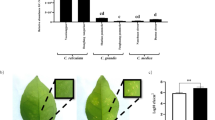Abstract
By means of differential display, a pool of salicylic acid (SA)-induced mRNAs were identified and subsequently their cDNAs were isolated from a cDNA library prepared from SA-induced leaf tissues of hot pepper. One of these cDNA clones, designated CaSIG4, was 1900 bp and contained an open reading frame encoding 523 amino acids with a calculated molecular mass of 56.3 kDa. The predicted amino acid sequence of CaSIG4 showed high sequence similarity to the AMP-binding protein family of both prokaryotic and eukaryotic acyl-CoA synthetases. CaSIG4 transcripts accumulated rapidly after SA treatment and in response to both incompatible and compatible interactions with Xanthomonas campestris pv. vesicatoria race 1. To investigate the cis-acting elements mediating CaSIG4 expression, the CaSIG4 5′-flanking region was isolated by inverse PCR. Database searches indicated that a potential cis-regulatory element is almost identical to the consensus core sequences ACC(A/T)ACC(A/C) which are conserved among promoters of other phenylpropanoid biosynthetic genes. The subcellular localization of the CaSIG4 protein was studied by using a soluble modified GFP gene fusion delivered into epidermal cells of onion by biolistic bombardment. The CaSIG4-smGFP fusion protein was localized to the plasma membrane. Taken together, CaSIG4 encoding a putative acyl-CoA synthetase could function as a plasma membrane-bound protein with a role in signaling in plant defense.
Similar content being viewed by others
References
Blobel, F. and Erdmann, R. 1996. Identification of a yeast peroxisomal member of the family of AMP-binding proteins. Eur. J. Biochem. 240: 468–476.
Casey, P.J. 1995. Protein lipidation in cell signaling. Science 268: 221–225.
Choi, D., Kim, H.M., Yun, H.K., Park, J.A., Kim, W.T. and Bok, S.H. 1996. Molecular cloning of a metallothionein-like gene from Nicotiana glutinosa L. and its induction by wounding and tobacco mosaic virus infection. Plant Physiol. 112: 353–359.
Creelman, R.A. and Mullet, J.E. 1997. Biosynthesis and action of jasmonates in plants. Annu. Rev. Plant Physiol. Plant Mol. Biol. 48: 355–381.
David, S.J. and Vierstra, R.D. 1996. Soluble derivatives of green fluorescent protein (GFP) for use in Arabidopsis thaliana. Weeds World 3: 43–48.
Delaney, T.P., Uknes, S.J., Vernooij, B., Friedrich, L., Weymann, K., Negrotto, D., Gaffney, T., Gut-Rella, M., Kessmann, H., Ward, E.R. and Ryals, J.A. 1994. A central role of salicylic acid in plant disease resistance. Science 266: 1247–1250.
Douglas, C.J. 1996. Phenylpropanoid metabolism and lignin biosynthesis: from weeds to trees. Trends Plant Sci. 1: 171–178.
Durner, J., Shah, J. and Klessig, D.F. 1997. Salicylic acid and disease resistance in plants. Trends Plant Sci. 2: 266–274.
Ecker, J.R. 1995. The ethylene signal transduction pathway in plants. Science 268: 667–675.
Fang, G., Hammar, S. and Grumet, R. 1992. A quick and inexpensive method for removing polysaccharides from plant genomic DNA. BioTechniques 13: 52–54.
Feinberg, A.P. and Vogelstein, B. 1983. A technique for radiolabeling a DNA restriction endonuclease fragment to high specific activity. Anal. Biochem. 72: 248–254.
Feuillet, C. 1995. Tissue-and cell-specific expression of a cinnamyl alcohol dehydrogenase promoter in transgenic poplar trees. Plant Mol. Biol. 27: 651–667.
Fulda, M., Heinz, E. and Wolter, F.P. 1997. Brassica napus cDNAs encoding fatty acyl-CoA synthetase. Plant Mol. Biol. 33: 911–922.
Gaffney, T., Friedrich, L., Vernooij, B., Negrotto, D., Nye, G., Uknes, S.J., Ward, E.R., Kessmann, H. and Ryals, J.A. 1993. Requirement of salicylic acid for the induction of systemic acquired resistance. Science 261: 754-756.
Gould, S.J., Keller, J.A., Schneider, M., Howell, S.H., Garrard, L.J., Goodman, J., Distel, B., Tabak, H. and Subramani, S. 1990. Peroxisomal protein import is conserved between yeast, plants, insects and mammals. EMBO J. 9: 85–90.
Grotewald, E., Drummond, B.J., Bowen, B. and Peterson, T. 1994. The myb-homologous P gene controls phlobaphene pigmentation in maize floral organs by directly activating a flavonoid biosynthetic gene subset. Cell76: 543–553.
Hauffe, K.D., Paszkowski, U., Schulze-Lefert, P., Hahlbrock, K., Dangl, J.L. and Douglas, C.J. 1991. A parsley 4CL-1 promoter fragment specifies complex expression patterns in transgenic tobacco. Plant Cell 3: 435–443.
Lamb, C. and Dixon, R.A. 1997. The oxidative burst in plant disease resistance. Annu. Rev. Plant Physiol. Plant Mol. Biol. 48: 251–275.
Liang, P. and Pardee, A.B. 1992. Differential display of eukaryotic messenger RNA by means of the polymerase chain reaction. Science 257: 967–971.
Logemann, E., Parniske, M. and Hahlbrock, K. 1995. Modes of expression and common structural features of the complete phenylalanine ammonia-lyase gene family in parsley. Proc. Natl. Acad. Sci. USA 92: 5905–5909.
Reymond, P. and Farmer, E.E. 1998. Jasmonate and salicylate as global signals for defense gene expression. Curr. Opin. Plant Biol. 1: 404–411.
Rogers, S., Wells, R. and Rechsteiner, M. 1986. Amino acid sequences common to rapidly degraded proteins: the PEST hypothesis. Science 234: 364–368.
Rushton, P.J. and Somssich, I.E. 1998. Transcriptional control of plant genes responsive to pathogens. Curr. Opin. Plant Biol. 1: 311–315.
Sablowski, R.W.M., Moyano, E., Culianez-Macia, F.A., Schuch, W., Martin, C. and Bevan, M. 1994. A flower-specific Myb protein activates transcription of phenylpropanoid biosynthetic genes. EMBO J. 13: 128–137.
Sambrook, J., Fritsch, E.F. and Maniatis, T. 1989. Molecular Cloning: A Laboratory Manual, 2nd ed. Cold Spring Harbor Laboratory Press, Plainview, NY.
Takeuchi, Y., Dotson, M. and Keen, N.T. 1992. Plant transformation: a simple particle bombardment device based on flowing helium. Plant Mol. Biol. 18: 835–839.
van den Ackerveken, G., Marois, E. and Bonas, U. 1996. Recognition of the bacterial avirulence protein AvrBs3 occurs inside the host plant cell. Cell 87: 1307–1316.
Ward, E.R., Uknes, S.J., Williams, S.C., Dincher, S.S., Wiederhold, D.L., Alexander, D.C., Ahl-Goy, P., Métraux, J.P. and Ryals, J.A. 1991. Coordinate gene activity in response to agents that induce systemic acquired resistance. Plant Cell 3: 1085–1094.
White, R.F. 1979. Acetylsalicylic acid (aspirin) induces resistance to TMV in tobacco. Virology 99: 410–412.
Author information
Authors and Affiliations
Rights and permissions
About this article
Cite this article
Lee, S.J., Suh, MC., Kim, S. et al. Molecular cloning of a novel pathogen-inducible cDNA encoding a putative acyl-CoA synthetase from Capsicum annuum L.. Plant Mol Biol 46, 661–671 (2001). https://doi.org/10.1023/A:1011677028605
Issue Date:
DOI: https://doi.org/10.1023/A:1011677028605




